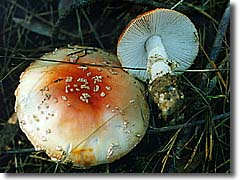Amanita muscaria
Fly Agaric, Fly Amanita

Amanita muscaria
600x450
JPEG - 40K
Cap: From round ball to convex to planar with age, 5 to 40 cm (2 to 16 inches) broad. Color variable, from bright red, blood, scarlet to orange/yellow to white to silver/gray/white, sometimes all at once; numerous white/gray warts from veil remnants, although these can wash off with age. Thick white flesh, firm but softening with age.
Gills: Broad, white, adnate (broadly attached), adnexed (narrowly attached) or free of stalk.
Stalk: White(ish), central, tapering up or straight, up to 4 cm (1.5 inches) thick, 5 to 20 cm (2 to 8 inches) long; basal bulb up to 6 cm (2.25 inches) thick.
Veil: Partial veil leaving ragged or toothed ring on stem, Universal veil leaving warts on cap and 2 to 4 layered vulva at stem bulb.
Spores: White print, broadly elliptical and smooth.
Habitat: Common; solitary, scattered, or in dense colonies and rings in conifer areas, natural or planted. Favors pine, spruce, fir and aspen.
Further Description and Comment: The infamous (or one of them, anyway) "magic mushroom" - the Fly Agaric is POISONOUS and HALLUCINOGENIC, as well very attractive to maggots. The effects vary greatly from person to person and mushroom to mushroom, the most common being at least an unpleasant experience all around. The principle toxin is ibotenic acid, but other toxins exist in varying quantities that exaggerate the nausea and vomiting experience. Ibotenic acid is converted to the more powerful form muscimol in the body, and affects the central nervous system, causing confusion, loss of muscular coordination, mild euphoria, profuse sweating, chills, visual distortions, and sometimes convulsions, hallucinations and delusions, and supposedly a feeling of greater strength. Sounds like a lot to go through for "mild euphoria." Quantities have the potential to be fatal. It also puts many people right to sleep, only to wake up hours later with the feeling they've been very sick. Whoopee.
The "Fly" is the basis for one of the most popular mushroom decorative motifs - it is indeed striking and beautiful - although many people don't realize it actually exists and how common it is. It is easily found in the large planted pine and fir stands on the coast - the pine and fir stand in the northeast section of San Pedro Point has an extensive colony with vast color variations that start coming out shortly after Thanksgiving and the first rains. The small trails that interlace along the hillside provide an afternoon of delightful mushroom viewing, especially if the sun is out and highlighting the patches of A. muscaria.
Some of the red Russulas may seem similar in coloration, but lack the stalk ring, bulbed base, vulva and distinctive fragments on the cap. Russulas also snap apart like chalk.
Collection is not recommended - even clean looking specimens will dissolve into balls of maggots within a day or two of bringing it home, and you wouldn't want the dog to accidentally ingest any of this. They last much longer if left undisturbed in the woods.